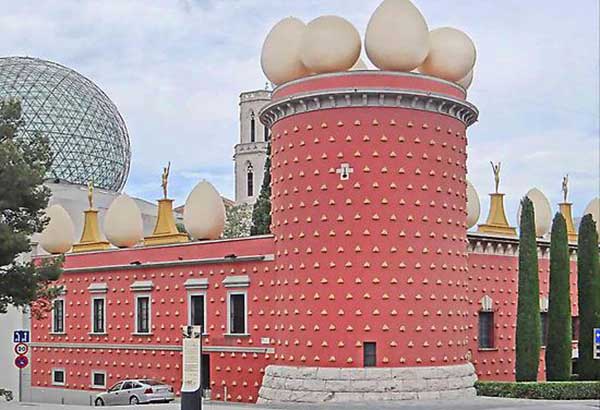In Figueres, we found Dali


Salvador Dalí Theater-Museum in Figueresa, Spain
Spain holds a distinct badge of honor, being the birthplace of some of the world’s great artists who have spread their artistic heritage throughout the country. These are artists who also form part of the country’s cultural and human landscape.Take, for example, Salvador Dalí.
Yes, Salvador Dalí is among the geniuses of the 20th century whose legacy can be admired and enjoyed most deeply.
My best friend Bum Tenorio and I had the privilege of visiting the Salvador Dalí Theatre Museum in Figueres, Spain. The small coastal town of Figueres, just north of Barcelona, is reportedly known for only one thing — Salvador Dalí’s quirky and whimsical museum.
It is worthy to note that the Salvador Dalí Theatre-Museum in Figueres is the biggest Dalí museum in Spain. Figueres is the capital of the comarca of Alt Empordà, in the province of Girona, Catalonia, Spain. The Dalí museum in Figueres was inaugurated in 1974. The large museum was designed by Dalí himself.
No doubt, Dalí, a master surrealist, is one of the most influential artists of the past century. To know him better is to explore the places where he stayed, lived and painted. This way, one gets to immerse one’s self in the most interesting museums that exhibit his work. These are unusual spaces that can only be found in Dalí’s native Spain, where the memory of the painter is very much alive. Born in Figueres, at the age of 20, the young artist became internationally known for “The Persistence of Memory,” featuring melting watches amid an eerily deserted backdrop, which is among his most famous paintings. When the artist was still quite young, his first public exhibition was on display at the local theater, which was later bombed and all but completely destroyed during the Spanish Civil War; it remained so until Dalí himself took the initiative to collaborate with the mayor to bring the structure back to its former splendor, in addition to a handful of other buildings and courtyards, as a museum dedicated to his work.
Found at the foyer of the museum is Dalí’s vintage car. It is an interactive art piece replete with a chauffeur inside the car that has its own smoke and rain machine.
In the interactive museum, seascapes will inspire you and villagescapes will transport you to where Dalí lived and died. You can also admire the imaginative extravagance in the decoration of homes and workshops, today museums, which demonstrate his creative genius.
Figueres, the town near Girona in which Dalí lived and died, will captivate you. The Dalí Theatre-Museum here is a humongous study in surrealist art, which brings together more than 1,500 artworks of Dalí, including the emblematic “Port Alguer,” “Galatea de las esferas” (“Galatea of the spheres”), the Mae West room, or “Cadillac lluvioso” (“Rainy Cadillac”), which join optical montages, holograms or stereoscopes never before imagined.
The Dalí Theatre-Museum is said to be the largest surrealistic object in the world. The building holds the widest range of the artist’s works, including everything from his earliest pieces to his final paintings. Dalí also chose to include some pieces from his personal collection by other artists such as El Greco and Antoni Pitxot.
Dalí himself is now a part of the Teatre-Museu as well — his crypt and grave are located here, quite fittingly, in the center of the museum. Reportedly, Salvador Dalí’s famous moustache remains in a perfect state, witnesses to the surrealist artist’s exhumation for DNA testing have revealed. Narcís Bardalet, Dalí’s embalmer, said that upon opening his crypt, the body was found to be exactly as it was when it was interred 28 years ago. (Just recently, another exhumation was ordered by a court to confirm a DNA paternity test requested by a female tarot card reader claiming to be Dalí’s daughter.)
The museum displays the single largest and most diverse collection of works by Dalí, the core coming from the artist’s personal collection. In addition to Dalí paintings from all decades of his career, there are sculptures, three-dimensional collages, mechanical devices and other curiosities from Dalí’s imagination. A highlight is a three-dimensional anamorphic living-room installation with custom furniture that looks like the face of Mae West when viewed from a certain spot.
Dalí conceived of and designed the museum himself. The museum in Figueres is a unique and bewitching experience and unlike any other art museum. Dalí spent his final years in the Torre Galatea of the museum and is buried there. The museum also exhibits the Dalí-Jewels, a fabulous collection of 39 jewels in gold and precious stones with drawings and paintings made by Salvador Dalí between 1941 and 1970.
To experience the most private aspect of the painter’s life and that of Gala, his muse, visit the Castillo Gala Dalí Museum-House. Exclusivity is the predominant feature of this Púbol medieval castle, in which paintings and drawings that Dalí gave as gifts to Gala are on display. An air of mystery surrounds the museum-house’s rooms, designed and decorated by Dalí. Marvel at the elephant sculptures that adorn the garden, the pool surrounded by busts of Wagner, or Gala’s haute-couture dresses, designed by one of the greatest geniuses of all time.
Equally enticing is a visit to what was for many years Gala and Dalí’s refuge: a walk through the Salvador Dalí Museum-House in Portlligat is a fantastic opportunity to surround yourself with the Catalonian artist’s particular scenery. Observation of Portlligat’s fisherman’s houses gave birth to the majority of his greatest works of art, and can be considered a work of art itself. A walk along the shores of the Mediterranean, a visit to his workshop, library and private rooms — these are experiences you won’t forget.
The richness of Dalí’s heritage is kept alive throughout Catalonia in important centers and museums. The Centre d’Art Perrot-Moore in Cadaqués, the Museu de Montserrat and the Museo Comarcal del Maresme are a few such places. The great contribution of Salvador Dalí to the world art and culture is manifested in many more of Spain’s museum collections. These are pieces that will incite you to continue on this cultural journey and discover the artist’s different creative stages. Prestigious museums in Madrid such as the Museo Nacional Centro de Arte Reina Sofía (MNCARS) or the Museo Thyssen Bornemisza, which are part of the famous “Paseo del Arte” (Art Walk), contain key works of the Dalí iconography. “Sueño causado por el vuelo de una abeja alrededor de una granada un segundo antes de despertar” (“Dream caused by the flight of a bee around a pomegranate one second before waking up”) or “Muchacha en la ventana” (“Girl in the window”) are just a small sample of what you will find in Spain’s museums and collections. Another museum that houses Dalí’s work is the Museu d’Art Espanyol Contemporani (Juan March Palma de Mallorca Foundation).
Spain is, therefore, the best place to discover or gain deeper insight into the life of this genius of surrealism, perhaps one of the most world-renown Catalonians in the history of Spanish art.
Dalí awaits you in Spain. In Figueres, Dalí’s works will blow your mind away.


















